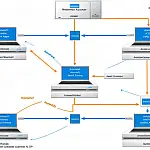How to Implement Rate Limiting in Your C# REST APIThis guide will walk you through the process of applying rate limiting to improve the performance of your C# REST API.
This article is part of a series of articles. Please use the links below to navigate between the articles.
- A Beginner's Guide to Building a REST API in C#
- Using Swagger to Document and Test Your C# REST API
- How to Add Authentication and Authorization to C# REST APIs
- Error Handling and Exception Management in C# REST APIs
- Data Validation and Error Handling in REST APIs using C#
- Versioning Your C# REST API: Best Practices and Approaches
- Caching Strategies for Improved Efficiency in C# REST APIs
- How to Implement Rate Limiting in Your C# REST API
Implementing rate limitations can be an excellent way to increase the performance of your C# REST API. Rate limitation allows you to limit the amount of API requests performed in a certain period, reducing overload and optimising performance.
Understand the Concept of Rate Limiting
You must understand the notion of rate limitation before implementing it in your C# REST API. Rate limitation is a strategy for controlling the amount of API calls made in a given period. You may prevent API overload and ensure optimal performance by limiting the amount of queries. This is very handy when dealing with APIs that have a high volume of traffic or require a lot of resources. Rate restriction can be accomplished in a variety of methods, including establishing a limited number of requests per minute or hour, or creating a token-based system.
Choose a Rate Limiting Strategy
When implementing rate limitations in your C# REST API, it is essential to select the best strategy for your specific requirements. You have several rate-limiting options to choose from, including a fixed window, sliding window, token bucket, and leaky bucket.
The fixed window technique limits the amount of requests that can be made within a given time frame. You can, for example, set a restriction of 100 requests per minute. When the limit is reached, any further requests will be refused until the next time frame begins.
The sliding window technique limits the number of requests inside a time window as well, but it provides more flexibility. Instead of a fixed window, the sliding window advances ahead indefinitely, allowing a limited number of requests each time interval. This means that if there is a sudden influx of requests, they can be granted as long as they fall within the sliding window.
Tokens are assigned to each request as part of the token bucket strategy. Each request consumes a token, and once the tokens have been emptied, all further requests will be refused until new tokens are added to the bucket. As long as there are enough tokens available, this technique allows for bursts of requests.
The leaky bucket approach works by emptying requests from a bucket at a constant rate. Any additional requests will be refused if the bucket is full. This method smooths out spikes of requests while maintaining a steady rate of processing.
Consider your API's specific requirements and select the rate-limiting technique that best meets your demands.
Steps To Implement Rate Limiting In Your C# REST API
Setting limits and thresholds for different API endpoints is an important stage of developing rate limiting for your C# REST API. This allows you to limit the number of requests made to each endpoint within a given time range. You may prevent abuse and ensure fair use of your API resources by defining limits and thresholds.
You can use different methods to create limitations and thresholds, such as setting a maximum number of requests per minute or hour for each endpoint. Limits can also be imposed based on the authentication level or subscription tier of the user. You can also set different restrictions for different sorts of requests, such as GET, POST, PUT, and DELETE.
Install the 'AspNetCoreRateLimit' Package
Install the AspNetCoreRateLimit NuGet package in your project using Visual Studio or your choice code editor.
dotnet add package AspNetCoreRateLimit
Configure Rate Limiting
Configure rate limitation in the ConfigureServices and Configure methods of your Startup.cs file. Rate-limiting policies can be defined, as well as rate limits for specific endpoints.
using AspNetCoreRateLimit;
using Microsoft.Extensions.Options;
public void ConfigureServices(IServiceCollection services)
{
/ Add the rate-limiting configuration
services.AddOptions();
services.AddMemoryCache();
services.Configure<IpRateLimitOptions>(Configuration.GetSection("IpRateLimiting"));
services.AddSingleton<IIpPolicyStore, MemoryCacheIpPolicyStore>();
services.AddSingleton<IRateLimitCounterStore, MemoryCacheRateLimitCounterStore>();
/ Other service configurations...
}
public void Configure(IApplicationBuilder app, IWebHostEnvironment env)
{
/ Other middleware...
/ Configure rate limiting middleware
app.UseIpRateLimiting();
/ Other middleware...
} Define Rate Limit Policies in appsettings.json
In your `appsettings.json`, define rate-limiting policies.
{
"IpRateLimiting": {
"ClientWhitelist": ["127.0.0.1"], / Optional: Whitelist certain clients
"EnableEndpointRateLimiting": true,
"StackBlockedRequests": true,
"RealIpHeader": "X-Real-IP", / Optional: To read real client IP from proxy
"ClientIdHeader": "X-ClientId", / Optional: To identify clients based on header
"HttpStatusCode": 429, / Status code to return for exceeded limits (Rate Limit Exceeded)
"GeneralRules": [
{
"Endpoint": "*",
"Period": "1m", / 1 minute
"Limit": 60
}
],
"EndpointRules": [
{
"Endpoint": "api/secure-data",
"Period": "1h", / 1 hour
"Limit": 100
},
{
"Endpoint": "api/other-endpoint",
"Period": "1d", / 1 day
"Limit": 1000
}
]
}
} These policies establish the rate restrictions for various API endpoints. You can tailor the rules to your own needs.
Apply Rate Limiting to Endpoints
Add [RateLimit] properties to your controller actions to apply rate restriction to certain endpoints.
[ApiController]
[Route("api")]
[RateLimit]
public class MyController : ControllerBase
{
[HttpGet("secure-data")]
[RateLimit(Name = "secure-data", Order = 1, Seconds = 60)]
public IActionResult GetSecureData()
{
/ Your secured endpoint logic here
}
[HttpGet("other-endpoint")]
[RateLimit(Name = "other-endpoint", Order = 2, Seconds = 3600)]
public IActionResult GetOtherEndpoint()
{
/ Your other endpoint logic here
}
} At the controller level, the [RateLimit] element implements the default rate restrictions defined in appsettings.json. The [RateLimit] attribute can be used to alter these defaults for individual activities.
With these instructions, you can configure your ASP.NET Core REST API for rate limiting and regulate the number of requests permitted per client for specified endpoints. Change the rate limit regulations, durations, and restrictions to meet your specific needs.











